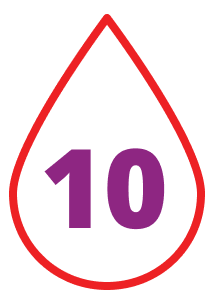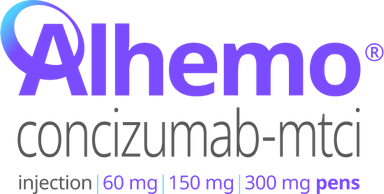Alhemo® is a tissue factor pathway inhibitor (TFPI)-antagonist indicated for routine prophylaxis to prevent or reduce the frequency of bleeding episodes in adult and pediatric patients 12 years of age and older with hemophilia A with FVIII inhibitors or hemophilia B with FIX inhibitors.

Challenges persist in managing hemophilia with inhibitors
Patients with HBwI are clinically underserved with a dire need for additional prophylaxis treatments1,2
High rate of bleeds occurred with current treatment options3
High rate of bleeds occurred with current treatment options2,3


Median ABR of

Patients using
on-demand BPAs
(n=16)
Median ABR of

Patients using
BPAs as prophylaxis
(n=15)
A descriptive, cross-sectional analysis was conducted using baseline characteristics and historical data including ABRs and treatment duration to describe real-world unmet needs in males aged ≥12 years with severe HA, moderate/severe HB, or HAwI/HBwI of any severity (N=31 patients with HBwI). BPAs were used on demand (n=16) for 111 months (mean) and as prophylaxis (n=15) for 85 months (mean). Due to the non-interventional design, study was subject to selection bias.3


How do your patients’ bleeds affect outcomes such as hospitalizations, absenteeism, or mobility challenges?
ABR=annualized bleeding rate; BPA=bypassing agent; HA=hemophilia A; HAwI=hemophilia A with inhibitors; HB=hemophilia B; HBwI=hemophilia B with inhibitors; IV=intravenous.
Significant treatment burden remains for patients managing HAwI2,6-10
Bleeds still occur
despite standard of care2,11
Bleeds still occur
despite standard of care2,11


~50%
n=70
of patients on FVIII mimetic experienced at least 1 spontaneous bleed8,a
aIn a real-world observational study at the Israeli National Hemophilia Center, breakthrough bleeding patterns were analyzed in patients with severe HA or HAwI receiving FVIII mimetic therapy prophylactically and completing 18 months of follow-up (n=28 patients with HAwI and 42 with HA without inhibitors). Results include patients with HA with and without inhibitors. Findings have not been confirmed by a clinical or randomized-controlled trial.8


There can be uncertainty surrounding individual response to treatment and limited ability to measure6
FVIII=Factor VIII; HA=hemophilia A; HA=hemophilia A; HAwI=hemophilia A with inhibitors.

Important Safety Information for Alhemo®
Contraindications
- Alhemo® is contraindicated in patients with a history of known serious hypersensitivity to Alhemo® or its ingredients
Warnings and Precautions
- Thromboembolic Events (TEs): Venous and arterial TEs were reported in 1.9% of patients (6/320) who also had multiple risk factors, including the use of high doses or prolonged treatment with factor product or bypassing agent (2 of 6 patients). Risk factors for TEs may also include conditions in which tissue factor is overexpressed (eg, atherosclerotic disease, crush injury, cancer, disseminated intravascular coagulation, thrombotic microangiopathy, or septicemia). Inform patients about and monitor them for signs and symptoms of TEs. In case of suspicion of TEs, discontinue Alhemo® and initiate further investigations and management strategies
- Hypersensitivity Reactions: Alhemo® is contraindicated in patients with a history of known serious hypersensitivity to Alhemo® or its ingredients. Hypersensitivity reactions, including erythema, rash, pruritus, and abdominal pain, have occurred in patients treated with Alhemo®. One patient (<1%) experienced anaphylaxis, which resolved after treatment with antihistamines and corticosteroids. Instruct patients of the signs of acute hypersensitivity reactions and to contact their healthcare provider for mild reactions and to seek urgent medical attention for moderate to severe reactions. Discontinue Alhemo® if severe hypersensitivity symptoms occur and initiate medical management
- Increased Laboratory Values of Fibrin D-dimer and Prothrombin Fragment 1.2: Increased levels of fibrin D-dimer and prothrombin fragment 1.2 were seen in 29 (9.1%) and 26 (8.1%) patients, respectively, which is positively correlated with the plasma concentration of concizumab-mtci, indicating a hemostatic effect. For patients taking Alhemo®, these coagulation biomarkers may not be reliable predictive markers for clinical decision-making with suspicion of thrombosis, such as deep vein thrombosis and pulmonary embolism
Adverse Reactions
- The most frequently reported adverse reactions (≥5%) were injection site reactions, headache, and urticaria
- Serious adverse reactions were reported in 6.1% of patients with inhibitors who received Alhemo®. Permanent discontinuation of Alhemo® occurred in 1 patient due to a renal infarct and dosage interruptions of Alhemo® occurred in 1 patient (3%) and was a hypersensitivity reaction
Drug Interactions
- Breakthrough Bleeding Treatment: Take appropriate precautions when treating breakthrough bleeding events in patients receiving Alhemo® prophylaxis and FVIII or FIX or a bypassing agent (eg, rFVIIa or aPCC). For mild and moderate bleeds, the lowest approved dose in the approved product labeling is recommended. For aPCC, a maximum dose of 100 units/kg within 24 hours is recommended. For severe bleeds, follow the dosing instructions in the approved labeling based on clinical judgment
Please click here for Alhemo® Prescribing Information.
Indications and Usage
Alhemo® (concizumab-mtci) injection 60 mg, 150 mg, or 300 mg is indicated for routine prophylaxis to prevent or reduce the frequency of bleeding episodes in adult and pediatric patients 12 years of age and older with hemophilia A or B with or without Factor VIII or IX inhibitors.
Important Safety Information for Alhemo®
Contraindications
- Alhemo® is contraindicated in patients with a history of known serious hypersensitivity to Alhemo® or its ingredients
Warnings and Precautions
- Thromboembolic Events (TEs): Venous and arterial TEs were reported in 1.9% of patients (6/320) who also had multiple risk factors, including the use of high doses or prolonged treatment with factor product or bypassing agent (2 of 6 patients). Risk factors for TEs may also include conditions in which tissue factor is overexpressed (eg, atherosclerotic disease, crush injury, cancer, disseminated intravascular coagulation, thrombotic microangiopathy, or septicemia). Inform patients about and monitor them for signs and symptoms of TEs. In case of suspicion of TEs, discontinue Alhemo® and initiate further investigations and management strategies
- Hypersensitivity Reactions: Alhemo® is contraindicated in patients with a history of known serious hypersensitivity to Alhemo® or its ingredients. Hypersensitivity reactions, including erythema, rash, pruritus, and abdominal pain, have occurred in patients treated with Alhemo®. One patient (<1%) experienced anaphylaxis, which resolved after treatment with antihistamines and corticosteroids. Instruct patients of the signs of acute hypersensitivity reactions and to contact their healthcare provider for mild reactions and to seek urgent medical attention for moderate to severe reactions. Discontinue Alhemo® if severe hypersensitivity symptoms occur and initiate medical management
- Increased Laboratory Values of Fibrin D-dimer and Prothrombin Fragment 1.2: Increased levels of fibrin D-dimer and prothrombin fragment 1.2 were seen in 29 (9.1%) and 26 (8.1%) patients, respectively, which is positively correlated with the plasma concentration of concizumab-mtci, indicating a hemostatic effect. For patients taking Alhemo®, these coagulation biomarkers may not be reliable predictive markers for clinical decision-making with suspicion of thrombosis, such as deep vein thrombosis and pulmonary embolism
Adverse Reactions
- The most frequently reported adverse reactions (≥5%) were injection site reactions, headache, and urticaria
- Serious adverse reactions were reported in 6.1% of patients with inhibitors who received Alhemo®. Permanent discontinuation of Alhemo® occurred in 1 patient due to a renal infarct and dosage interruptions of Alhemo® occurred in 1 patient (3%) and was a hypersensitivity reaction
Drug Interactions
- Breakthrough Bleeding Treatment: Take appropriate precautions when treating breakthrough bleeding events in patients receiving Alhemo® prophylaxis and FVIII or FIX or a bypassing agent (eg, rFVIIa or aPCC). For mild and moderate bleeds, the lowest approved dose in the approved product labeling is recommended. For aPCC, a maximum dose of 100 units/kg within 24 hours is recommended. For severe bleeds, follow the dosing instructions in the approved labeling based on clinical judgment
Please click here for Alhemo® Prescribing Information.
Indications and Usage
Alhemo® (concizumab-mtci) injection 60 mg, 150 mg, or 300 mg is indicated for routine prophylaxis to prevent or reduce the frequency of bleeding episodes in adult and pediatric patients 12 years of age and older with hemophilia A or B with or without Factor VIII or IX inhibitors.
References:
- Lewandowska M, Nasr S, Shapiro AD. Emerging therapies in hemophilia: improving equitable access to care. J Blood Med. 2025;16:95-115.
- Srivastava A, Santagostino E, Dougall A, et al. WFH guidelines for the management of hemophilia. Haemophilia. 2020;26(suppl 6):1-158.
- Windyga J, Apte S, Frei-Jones M, et al. Disease and treatment burden of patients with haemophilia entering the explorer6 non-interventional study. J Haematol. 2024;113(5):631-640.
- FEIBA® [package insert]. Takeda Pharmaceuticals USA, Inc; 2024.
- Shapiro AD, Mitchell IS, Nasr S. The future of bypassing agents for hemophilia with inhibitors in the era of novel agents. J Thromb Haemost. 2018;16(12):2362-2374. doi:10.1111/jth.14296
- Nardi MA. Hemophilia A: emicizumab monitoring and impact on coagulation testing. Adv Clin Chem. 2023;113:273-315.
- HEMLIBRA® [package insert]. Genentech, Inc; 2024.
- Levy-Mendelovich S, Brutman-Barazani T, Budnik I, et al. Real-world data on bleeding patterns of hemophilia A patients treated with emicizumab. J Clin Med. 2021;10(19):4303.
- Arendt-Nielsen L, Egekvist H, Bjerring P. Pain following controlled cutaneous insertion of needles with different diameters. Somatosens Mot Res. 2006;23(1-2):37-43.
- Usach I, Martinez R, Festini T, Peris JE. Subcutaneous injection of drugs: literature review of factors influencing pain sensation at the injection site. Adv Ther. 2019;36:2986-2996.
- National Bleeding Disorders Foundation. MASAC Document #268. MASAC Recommendations on the use and management of emicizumab-kxwh (Hemlibra®) for hemophilia A with and without inhibitors. National Bleeding Disorders Foundation. Adopted April 27, 2022. Accessed May 16, 2025. https://www.bleeding.org/sites/default/files/document/files/268_Emicizumab.pdf
